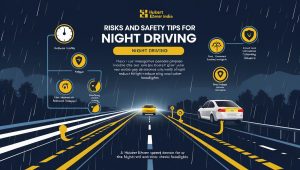🏞️ How to Adapt Driving Style Based on Terrain – A Practical Guide by Hubert Ebner India
India’s diverse geography demands more than just basic driving skills. Whether you’re navigating mountain roads, desert stretches, or congested city streets, adapting your driving style based on terrain is crucial for safety and efficiency. At Hubert Ebner India, our driver training programs are tailored to Indian terrains challenges. Here’s how professionals—and everyday drivers—can become more terrain-aware behind the wheel.
🧗 1. Hilly & Mountain Terrain: Control is Key
Driving in regions like Himachal, Uttarakhand, or the Western Ghats requires:
- Lower gears on inclines & descents
- Avoiding unnecessary overtakes on curves
- Using engine braking rather than relying solely on brakes
- Awareness of landslide zones and narrow roads
👉 Hubert Ebner’s hill driving module emphasizes clutch-brake coordination and visual scanning techniques to anticipate blind turns.
🏜️ 2. Desert & Arid Zones: Stability Over Speed
In Rajasthan or Gujarat’s dry zones, terrain challenges include:
- Loose sand on the roadside = high skid risk
- Glare and heat distortion can affect depth perception
- Vehicle overheating in extreme heat
👉 We train commercial drivers on load distribution, tire pressure control, and defensive driving for desert conditions.
🏙️ 3. Urban Terrain: Reactivity & Anticipation
Driving in metro cities like Delhi, Mumbai, or Bengaluru demands:
- Constant lane discipline
- Awareness of pedestrians, two-wheelers, e-rickshaws
- Handling frequent stop-and-go traffic
- Navigating multi-level flyovers and intersections
👉 Our urban behavior training includes simulation-based hazard anticipation, especially for commercial and delivery fleets.
🛤️ 4. Rural & Village Roads: Caution and Courtesy
In rural terrains, drivers often face:
- Unmarked roads and sudden obstacles like cattle or potholes
- Lack of lighting and sharp, narrow turns
- Children playing near roads or improper vehicle parking
👉 Our rural-focused curriculum promotes lower speed driving, horn usage discipline, and anticipation of human/animal movement.
🌧️ 5. Flood-Prone or Slippery Terrain: Grip Management
In monsoon zones and hilly regions:
- Risk of hydroplaning and brake failure
- Poor visibility from fog, rain, or mist
- Unpredictable road surfaces—mud, moss, gravel
👉 Hubert Ebner India trains drivers in weather-aware speed adjustment, brake feathering, and vehicle control on gradients.
🚧 6. Construction & Temporary Terrain: Stay Alert
In both urban and highway stretches, construction zones change terrain patterns:
- Temporary detours
- Loose gravel or diverted lanes
- Missing signage or barricades
👉 Our programs include visual scanning training and how to adjust steering and speed when navigating such temporary terrains.
🧭 Why Terrain-Specific Driving Matters
Failing to adjust driving style to the terrain can result in:
- Increased accident risk
- Higher vehicle wear & tear
- Fuel inefficiency
- Driver fatigue
At Hubert Ebner India, our goal is to help drivers move from reactive to terrain-smart driving.
🛠️ How We Train Terrain-Adaptive Driving
- Region-wise simulation setups
- Real-world case studies (mountain crashes, rural collisions, urban fender benders)
- Hands-on modules for fleet operators, school bus drivers, long-haul truckers, and private chauffeurs
- Telematics-based feedback on terrain-specific behavior
🚗 Smart Driving = Safer Roads
By recognizing how different terrains affect vehicle performance, visibility, and human behavior, drivers become more confident and less prone to error.
📞 Partner with Hubert Ebner India to upgrade your team’s skills for any terrain—urban or remote, hilly or coastal.




